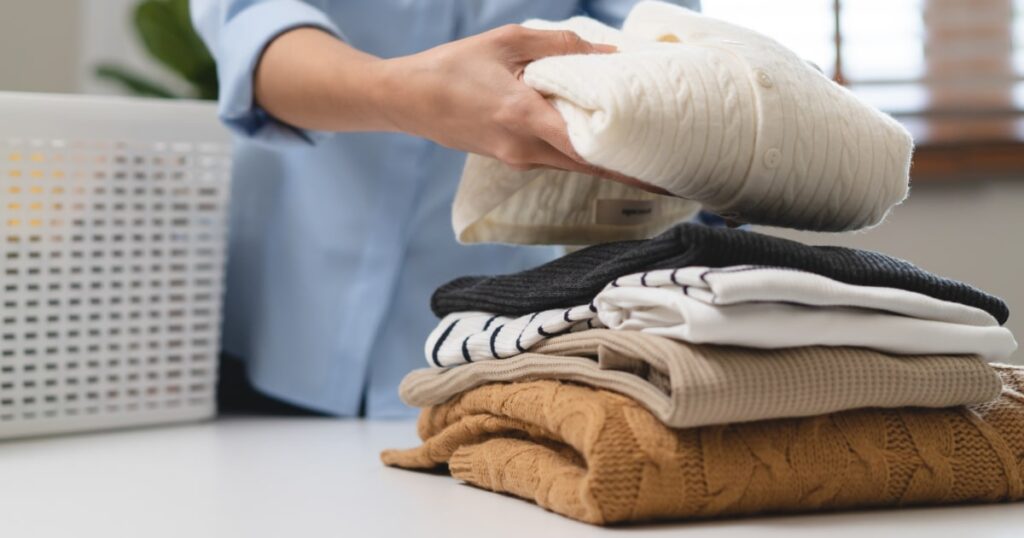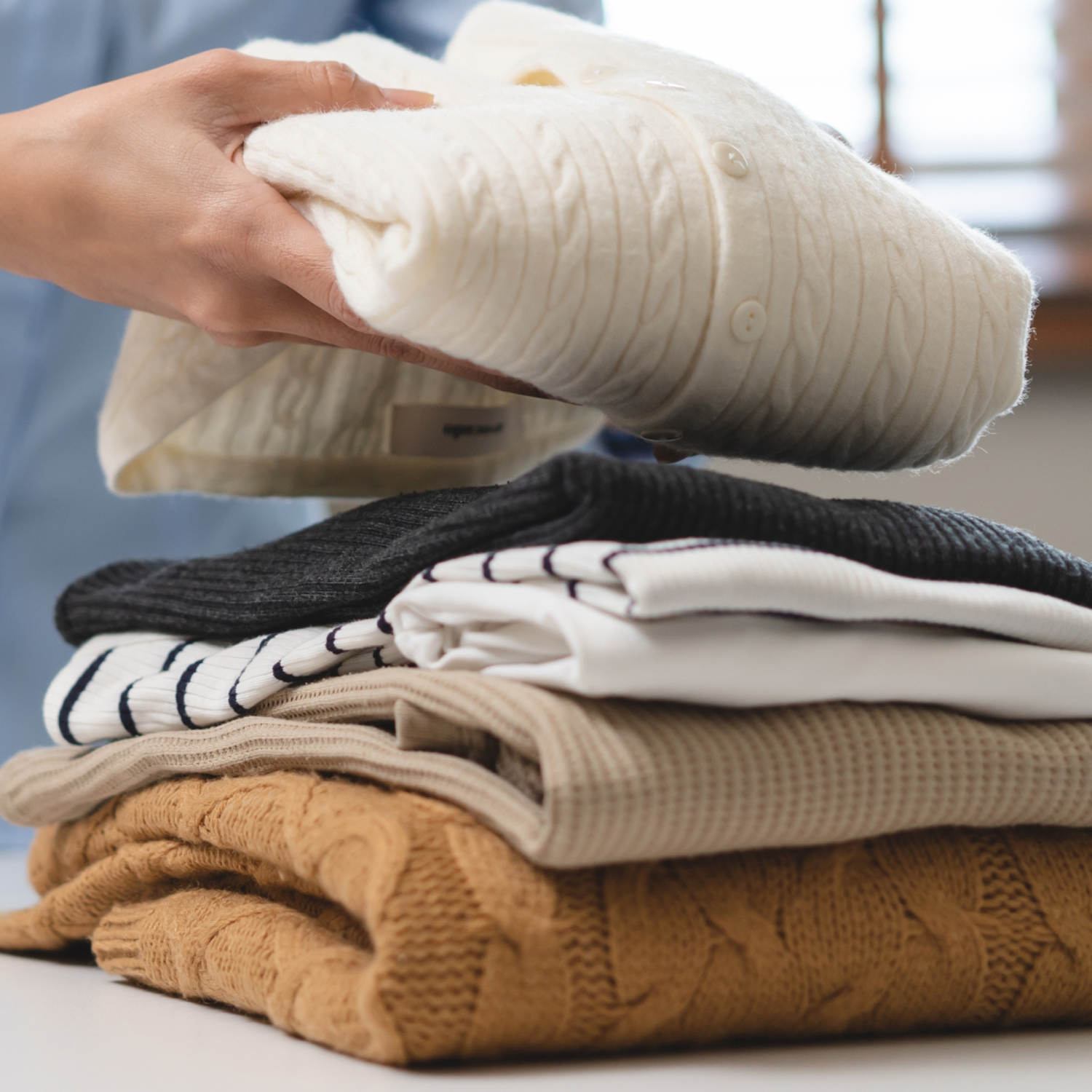

We don’t always have the answers, but we have some people on speed dial who do — which is why we present to you our series FYI where we have experts explain if lip balm is actually bad, how often should you wash your hair and more.
When laundry day rolls around, it’s tempting to simply throw everything that has been lying in the hamper directly into the washer. While washing all of your garments together saves time and energy, it’s not the optimal way of preserving the longevity of your clothing and bedding. It’s worth it to separate and wash clothing, bedding and fabric types into their own wash cycles. That’s because various types of clothing react differently under certain conditions, and they may not mesh well given their varied textures. Washing incompatible fabrics and colors can lead to piling, ripping, color bleeding and dingy-looking whites.
You should always look at the care label instructions on your clothing, but if you need extra insight, consider our guidance below. To find out the best ways to clean many different types of clothing, including denim, cotton, wool, polyester and satin, we spoke with cleaning experts for their insight and product recommendations.
SKIP AHEAD How we picked the products for cleaning clothes | How to clean different types of clothing and bedding
How we picked the products for cleaning clothes
You can use laundry detergents, fabric softeners and dryer sheets to clean many common fabrics, however, you should use them carefully and only if necessary, depending on the fabric type. Additionally, make sure to wash clothing in the appropriate water temperature and turn them inside out if needed. Our experts recommend keeping the following in mind when looking for laundry supplies.
- Fabric type: The type of fabric that you’re washing often determines what types of wash and dry cycle is best. Clothing and bedding come in a ton of different materials, but the most common are cotton, linen, wool, polyester, nylon, rayon, fleece and silk. Each of these materials behaves differently in hot and cold water and with different types of detergent. The laundry symbols on clothing tags often look indecipherable but it can offer directions for how best to launder your clothes to prevent it from shrinking or getting damaged. That said, some fabrics are highly susceptible to shrinking, depending on their overall quality.
How to separate clothes before washing them
“Properly separating clothing based on fabric is crucial to ensure they are cleaned effectively and to prevent damage,” says Zack Saifi, chief revenue officer at Madame Paulette, a luxury cleaning and restoration services company in New York City. Below, Saifi guides us on the best way to separate clothing for laundry, including which fabric types are fine to wash together.
Cotton and linen: You should wash cotton and linen together, according to Saifi. “Both can withstand higher temperatures and are generally more durable,” he says. Most clothing fabrics are made of cotton and/or some sort of cotton blend. This includes shirts, pants, sweatshirts, hoodies, bedding and socks, to name a few. Linen is also commonly used to make some of the same articles of clothing, however, it’s also used to make tablecloths, sheets and other household fabrics.
Synthetics (polyester, nylon, acrylic): This often includes yoga pants, tights and other flexible workout apparel. It’s best to wash these synthetic materials together, since they all have similar properties and cleaning needs, according to Saifi. Polyester, nylon and acrylic are known as synthetics because they’re made from chemical fibers, rather than organic materials. You’ll find many types of clothing, bedding, bags and other accessories made from polyester, nylon and acrylic.
Delicates (silk, lace, satin, velvet): As the name implies, delicates are fragile articles of clothing like lace gowns or silk shirts, and are more susceptible to damage in the wash. You should wash these on their own using your washer’s delicate or gentle cycle, according to Saifi. In fact, Saifi recommends putting delicates in a mesh laundry bag before washing them for added protection.
Wool and cashmere: You should wash these fabrics on their own in a delicate cycle to prevent felting and stretching, according to Saifi. If possible, Saifi also recommends handwashing certain wool and cashmere articles of clothing if you’re worried about them getting damaged. Wool and cashmere often encompasses garments like sweaters, pullovers and cardigans.
Towels: While many towels are made of cotton, similar to shirts, pants and bedding, you should still wash them in their own cycle to ensure they’re thoroughly cleaned. Plus, many towels have a particular type of weave and weight, such as terry cloth, which is different from a more common cotton weave.
Dark and light colors: Lastly, you should always clean dark and light colors separately for the best results, according to Saifi. “Even within the same fabric group, separate dark and light colors to prevent dye transfer,” says Saifi. This is also a good way to maintain the vibrancy of your clothing and help prevent white fabric from looking dingy or dull.
How to clean different types of clothing and bedding
T-shirts, dress shirts, tank tops, bedding, cotton-based pants
Water temperature: Cold to warm (30-40°C or 86-104°F)
Wash cycle: Normal to gentle
Dryer temperature: Medium heat
Turn inside out? Yes
The large majority of your clothes may likely fall into this section. For common garments like basic T-shirts, cotton-based button-down shirts and pants, tank tops and bedding, it’s best to use cold to warm water, according to Saifi. Be sure to use the normal or gentle cycle if your washer has one and dry in medium heat. In addition to a gentle detergent, Saifi recommends using a color catcher, such as the Shout Color Catcher Sheets, which prevents colors from bleeding into one another. Also, if your clothes attract a lot of hair or dust, use a quality dryer sheet, such as the Bounce Pet Hair and Lint Guard.
Underwear, bras, shapewear, activewear, tights, lingerie (delicates)
Water temperature: Cold
Wash cycle: Gentle or hand wash
Dryer temperature: Low heat (with a mesh bag) or air dry
Turn inside out? Yes
Items such as underwear, bras, shapewear and tights are often considered delicates, since they’re made of either thin and/or fragile fabric that can tear easily, such as silk, chiffon and satin. If your underwear is made from more durable cotton, they should be fine to add in with the T-shirts and tank tops, otherwise wash delicates in cold water or hand wash them. NBC Select associate updates editor Zoe Malin uses the Soak Scentless Laundry Detergent to wash delicates. “When I started writing about bras in 2021, an expert told me about Soak and I’ve been buying it ever since,” she says. “I use it to hand-wash my sports bras, bralettes and regular bras, and you can also use it with a laundry machine.” If you plan on adding delicates to the dryer, use low heat and place them in a mesh bag.
Socks
Water temperature: Warm (30 to 40°C or 86 to 104°F)
Wash cycle: Normal
Dryer temperature: Medium heat
Turn inside out? Yes
While socks come in a variety of thicknesses and flexibilities, it’s best to wash them in warm water, in a normal cycle using medium heat, according to Saifi. This will help clean them thoroughly, while also getting rid of the odors they often hold onto from sweat. Malin also uses Dropps Activewear Biobased Laundry Detergent Pods to clean clothes that commonly come in contact with sweat, such as yoga pants. “I’ve been using Dropps active wash laundry detergent pods for about four years, and they work incredibly well,” she says. “I love that they’re made from sustainable materials rather than harsh chemicals, which is great for my sensitive skin, too.”
Jeans, shorts and jackets
Water temperature: Cold
Wash cycle: Normal
Dryer temperature Low to medium heat (or air dry)
Turn inside out? Yes
Many people have some form of denim pants in their closet, you should be sure to wash them carefully to preserve their color and shape. Saifi recommends washing jeans in cold water only in a normal cycle and using little to no heat to dry them. In fact, it’s often better to air dry jeans, according to Saifi, because the heat can cause them to shrink, fade or become misshapen. Also, similar to printed T-shirts and clothing made from synthetic material, such as activewear, you should turn jeans inside out before washing them. This prevents them from being damaged or piling, according to Saifi.
Sweaters, cardigans and pullovers
Water temperature: Cold
Wash cycle: Gentle or hand wash
Dryer temperature: Low heat or lay flat to dry (dryer not recommended)
Turn inside out? Yes
Sweater, cardigans and pullovers are usually made of wool,cashmere or occasionally fleece, according to Saifi. You should wash them in cold water on a gentle cycle (or hand wash if possible) and let them air dry by laying them flat on a surface (don’t hang them in general, especially to dry, as they’ll stretch) or use the lowest heat setting on your dryer. You should also turn them inside out before washing them to prevent pilling, which is common in wool and cashmere garments. Plus, you’ll want to use a dryer ball to help get rid of any lint or hair stuck to the clothes.
Sweatpants, sweatshirts, crewnecks and hoodies
Water temperature: Cold to warm (30-40°C or 86-104°F)
Wash cycle: Normal
Dryer temperature: Medium
Turn inside out? Yes
To wash more casual garments like sweatshirts and hoodies, use cold to warm water, on a normal cycle with moderate heat. You should also turn them inside out before washing them. They’re typically made of cotton or some of the same materials used to make sweaters, given their insulating properties. If you’re washing clothes in this category that have particularly bright colors or graphics, consider using the Carbona Color Grabber to make sure the colors don’t run.
Towels
Water temperature: Hot (60°C or 140°F)
Wash cycle: Normal to heavy-duty
Dryer temperature: High heat
Turn inside out? N/A
While they’re not technically clothing, towels take up a good amount of room in our laundry hampers, and they often are the most odorous. That’s because they frequently come in contact with moisture, sweat, hair and dead skin, which means they’re a hub for bacteria and unpleasant smells. This is why Saifi recommends washing towels in a hot water cycle. Additionally, use a normal or even heavy-duty cycle to get towels thoroughly clean. The Oxiclean Odor Blasters Stain Remover powder is effective in cleaning and eliminating odors, and it’s both chlorine-free and color-safe, according to the brand.
Meet our expert
- Zack Saifi is the chief revenue officer at Madame Paulette, a cleaning and clothing restoration services company based in New York City.
Why trust NBC Select?
Cory Fernandez is a commerce editor at NBC Select, where he covers cooking, cleaning, wellness and other lifestyle-related content. He’s written multiple cleaning guides for the site, including how to white clothes without bleach, how to clean a reusable water bottle and how to clean a mattress.
Catch up on NBC Select’s in-depth coverage of personal finance, tech and tools, wellness and more, and follow us on Facebook, Instagram, Twitter and TikTok to stay up to date.
 Tops Top News Online Real News Portal
Tops Top News Online Real News Portal 





